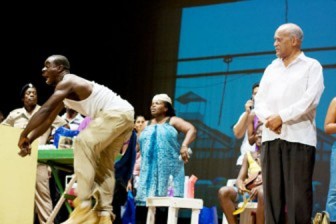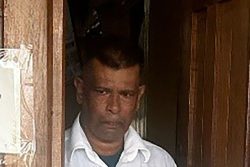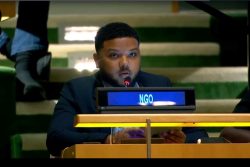The annual satirical revue Link Show 27 directed by Ron Robinson and produced by The Theatre Company and GEMS Theatre Productions provoked a number of letters and comments in the press in February 2011. These included reactions to both content and quality, complaints about extravagance, questions of fairness, and the nature and functions of satire raised by prominent public officials such as Steve Surujbally and Michael Khan. There were concerns about the image of the public hospital, the relentless bashing of a government minister and the quality of the skits. These, along with Robinson’s response in defence of his theatre, put a critical focus not only on this Link Show but on satirical theatre in the present Guyanese society, whether it is destructive, misleading, fair comment, important and responsible vehicle for social control or mere trivial entertainment.
Since its triumphant resumption in 2009 The Link has been considerably stronger than it had been before. There has been a definite rise in quality since then, with all three productions in 2009, 2010 and 2011 maintaining that new high standard. It now has a settled formula and a confident style of presentation, is well directed, efficiently managed and effectively performed. Of those three since the reunion of Gem Madhoo and Robinson, Number 25 remains the best of them all, reaching a zenith of excellence with Number 26 falling not far behind and now Number 27 climbing down a bit. Yet, in terms of presentation it was a very good production with strong, effective acting and resounding audience impact. It was characteristically fast-moving, perfectly paced and particularly disciplined in presentation, precise timing and fluent transition from one item to the next. But it did not reach the all-round strength of Number 25 in 2009.
The issues and questions arise from its content and the quality of its scripts. The main contention had to do with the take-off of the Georgetown Public Hospital which was seen as an over-exaggerated misrepresentation of an institution that provides good service and on which the nation has to depend, and the lampoon of Minister Rohee, which was seen as excessive and an abnormal targeting of one individual. Dr Surujbally had raised the point in another letter about a Paul Harris cartoon. Satire, he said, should not damage a public institution for the sake of a laugh by associating it with fraudulent practice; particularly when the association is not accurate, it can do permanent injury to an institution that the public needs to trust. It seems there was similar concern about the lampoon of the hospital and its nurses.

Robinson’s reply sought refuge in the nature and function of satire, pleading fair comment and artistic licence according to his interpretation of satire and the nature of a revue. It is normal and not unusual for a satirical revue to challenge authority, to target politicians and social ills. National politics is always fair game and the government or ruling party is always the most popular target because they are in power, they are the most visible and they represent authority. In addition, Robinson was correct about one of the methods of satire, which is exaggeration.
Caricature highlights a particular flaw or piece of folly, blowing it up larger than life for humour and effectiveness. However, Robinson seems to feel that being lampooned in a revue is a compliment paid to the subject. To be criticised in the Link is an indication that you have done something right to ‘deserve’ it. What has become of the classical practice that you lampoon someone because they have been guilty of some vice or folly?
It is true that the Minister of Home Affairs was notably harried. But he need not feel unnecessarily victimised; one may refer again to the fact that politicians and officials in authority are always prime targets. To go further, another method of satire refers here as well. Picong and satire pounce on certain vulnerable pronouncements. One has to admit that a public statement like “goat ain’t bite me,” invokes humour and in the context in which it was uttered, stood up as obvious fodder for picong. It put its hand up and asked to be satirised. However, the fact that this is so is a different statement about our attitudes to our language. Mr Rohee was resorting to Guyanese colloquial speech in light-hearted fashion, but Guyanese are still to recognise their own language and their own idioms as legitimate, if not official forms of linguistic expression.
Having said that, Link Show 27 forgot that national political and social satire are not only about the ills of the government or even the area of politics. There are also vice and ills committed by citizens and the rest of the population. These social ills, vice and folly so prevalent among the people can be pounded as hard as the government was pounded. Satire seeks to isolate and eradicate those malignant habits as well. There was only one mild humorous touch on the rampant scourge of domestic violence which accounts for a riot of murders and attacks on women, to cite just one issue.
Here again, Dr Surujbally’s comment is apposite. Satire has moral responsibilities and needs to be sensitive to behaviour and to what is good for the society it criticises. According to how it treats an issue it can run the risk of counter-productivity – undoing what it tries to achieve. It cannot be immoral or amoral in the positions it seems to take and must give clear messages to its audience about what is unacceptable. There is really no need to be worried about the lampooning of the hospital or the Minister, but one skit titled The Pole, which treated GPL and the disconnection of customers raises some concern. A GPL technician disconnects a customer for non-payment and is menacingly threatened by the irate customer wielding a cutlass and forced to reconnect his supply. The audience has a good laugh at the expense of the GPL technician. But is there not a serious problem concerning violence and threats of violence against disconnection crews and staff removing illegal connections? And isn’t this a criminal practice that is to be clearly discouraged? The link needs to be careful about how it approves of the victim of this criminal violence presented as the butt of the joke and his attacker as the hero.
In another skit called The Ms Guyana Pageant the presentation of ‘Miss Guychina’ is also a bit troubling. In this and other dramatisations references are made to Chinese in a manner bordering on ridicule of the race and the nationality and in a manner bordering on racial intolerance. Satire seeks to root out evils, not entrench them among people in a society where there is ethnic intolerance. This is no way to treat an immigrant community made up of a minority group in your country.
On the other hand there were dramatisations that were very good examples of satirical take-off that showed very well how it is to be done. On the very subject of illegal electricity connections a case in point was the skit titled Illegal Prepaid which took a good laugh at pertinent ironies in the practice in such a way that makes it clear it is not condoned. Similarly the Minibus Drivers’ Convention and the ‘Quickie’ Touting were excellent lampoons of the errant minibus sub-culture, showing that the Link does possess the skills to present good satire.
Inasmuch as some presentations such as Plain Talk 3 were simply statements spoken from the stage without artistic input, there were many others which confirmed the capacity for the practice of the art. It must also be mentioned that a satirical revue like The Link is taken for granted in Guyana where it can be as outspoken and as critical as it wishes. There are other countries where dramatists and writers are jailed or executed. There are societies where such work is banned.
Among a number of other things Link Show 27 established this annual revue as among the best in the Caribbean. In Guyana there are other comic productions sometimes erroneously calling themselves satire. But The Link stands out above them as Mount Everest among the foothills around Linden. There is no comparison and it may be considered a distinct achievement for Gem Madhoo-Nascimento and Ron Robinson, The Theatre Company and GEMS Theatre Productions.









